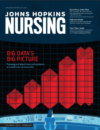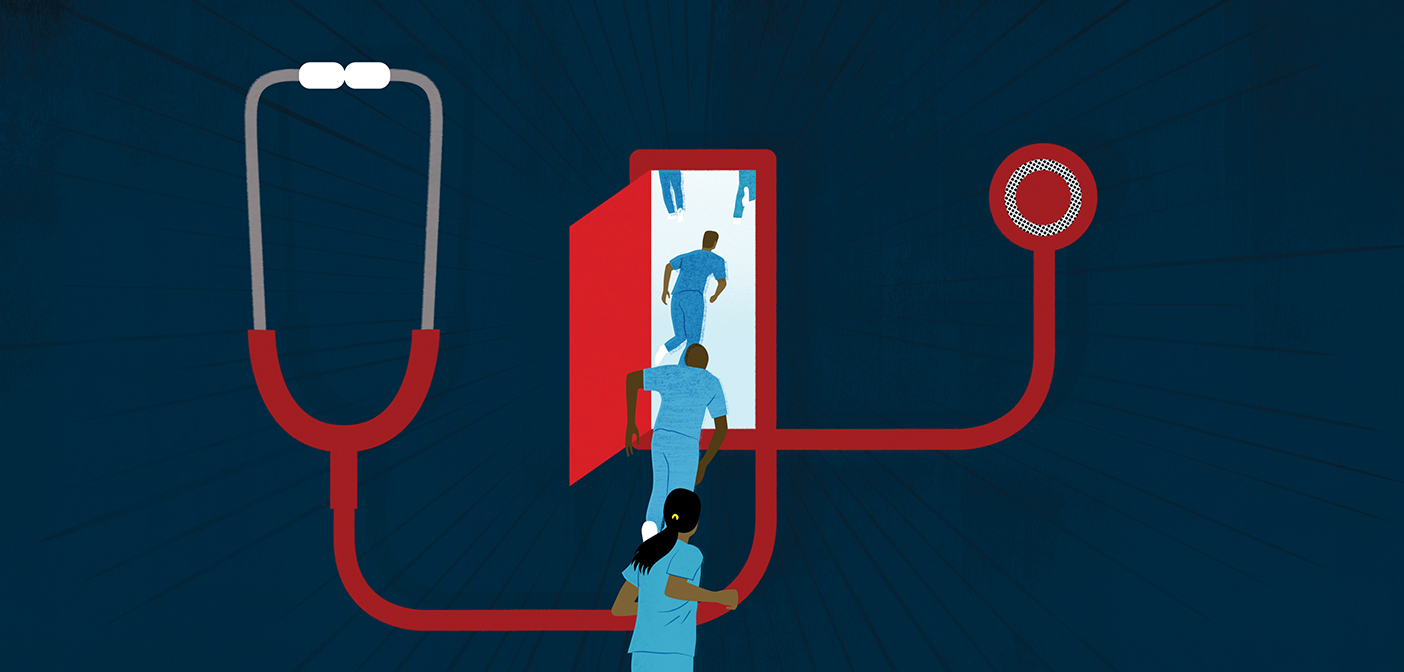By Steve St. Angelo
Nurses are key figures in turning great numbers into best practices
The term “big data” is thrown around so loosely these days. It’s a catchphrase for all the statistics, crunched numbers, charts, schematics, and other brain propellants behind great advances in patient safety and quality of medical care (and engineering, and economics, and … apparently everything). But perhaps we don’t understand its true meaning or importance here on the ground, where red blood and big data meet. Here are some large numbers we all can understand: Up to 75 percent of antibiotics prescriptions in the U.S. are for upper respiratory infections (antibiotics work in only a fraction of these cases), with such misuse creating drug-resistant “superbugs.” At least 3.2 million Americans have hepatitis C and up to 85 percent don’t know they have a deadly but curable virus. More than 8 million healthcare workers are employed in settings where they are exposed to hazardous drugs by leaks, vapors, or residue. These can cause cancers, infertility, and other serious health problems. Data are at the root of possible solutions sought by students in the Doctor of Nursing Practice program at the Johns Hopkins School of Nursing to these and other real-world problems. They are poring over the numbers, naturally, but also studying the people, the systems, the cultures, the hows, whys (and why-on-earth nots?) behind life-and-death issues. From their big data, clear answers emerge.
The Antibiotics Equation
In the middle of cough-and-cold season, Melissa Jones-Holley, MSN, APRN, FNP-c, was standing her ground against superbugs, and getting plenty of support. An intervention at Carroll Hospital Center My Care Now that she’d developed and helped to initiate had drastically cut antibiotic prescriptions for upper respiratory infections (URIs) at the Maryland clinics. And people were getting better anyway. The simple explanation, Jones-Holley explains, is that in some 80 percent to 90 percent of cases, URIs are viral in nature. Antibiotics help to cure bacterial infections, not viral ones. So, many antibiotics are being prescribed unnecessarily. Patients get well either way, so the message received is too often: get URI, get antibiotics (feel better, stop taking the antibiotics, help create drug-resistant bacteria), repeat. It’s a cycle Jones-Holley is determined to break. “We have taken steps to improve the health of our community,” Jones-Holley says of medical advances that brought so many killer microbes under control in the first place. “We’re not going back to a time when people died of simple infections.”So, armed with her data, Jones-Holley embarked on an intervention to decrease antibiotics prescriptions by putting providers on a common course. “The intervention we chose was to pull the full-time providers together and say, ‘Here’s the
“We have taken steps to improve the health of our community. “We’re not going back to a time when people died of simple infections.”
—Melissa Jones-Holley, MSN, APRN, FNP-c
problem. Here are the guidelines.’ We got consensus to adopt the guidelines.” Next, Jones-Holley used peer feedback and an audit to show providers where they fell on a graph of prescribers, offering a gentle nudge in the preferred direction. Then came educating patients. “We want them to be on board,” she says, so patients discharged without antibiotics receive materials that explain why, including a Centers for Disease Control pamphlet called Get Smart: Know When Antibiotics Work. Its simple message:“Bacteria cause strep throat, some pneumonia, and sinus infections. Antibiotics can work.”
“Viruses cause the common cold, most coughs, and the flu. Antibiotics don’t work.”
Jones-Holley and her team set a data point, aiming for 80 percent provider compliance (they got 87 percent). This is even allowing for part-time providers and parents who won’t take “no antibiotics” for an answer. “There is always going to be an insistent parent—‘This has worked for my child before’—and the key is to really have a conversation.”Jones-Holley’s team also developed a protocol to quickly identify bacterial cases and properly treat them with antibiotics. “We can do tests here,” she says of My Care Now. “And all patients are advised to follow up with us or their healthcare provider if their symptoms worsen or persist.” Before the intervention, antibiotics were handed to suspected URI patients 74.4 percent of the time. Now it’s 56.8 percent, “which is awesome,” Jones-Holley says.
Closing the Loop
On the day Washington passed a law on the safe handling of hazardous drugs in medical settings, the first state in the nation to do so, Rachael Crickman, MN, RN, remembers being struck “that there was not already a mandatory requirement.” According to the Bureau of Labor Statistics and the Centers for Disease Control, in 2010, more than 8 million healthcare workers were employed in settings where they were potentially exposed to hazardous drugs, with chemotherapy drugs among the most toxic. And many did not wear proper personal protective equipment, or PPE, for various reasons: among them the bother or inaccessibility of PPE or simply a lack of knowledge or encouragement.In 2008, the chemo unit at Virginia Mason Medical Center in Seattle, Crickman’s first stop as a clinical nurse specialist, was not unlike most others nationwide. There was a system to alert for patient safety events, but not a comprehensive system to capture events or exposures involving staff members. There were policies in place for reporting exposures from spills or other events, yet no reports had been filed. This, Crickman learned, was despite a number of hazardous drug spills. “Safety measures that I had benefited from were not in place here,” she says. An oncology nurse herself for 15 years, Crickman suspected symptoms she’d noticed among nurses on the chemotherapy unit at a previous hospital—infertility, for instance—might be due to exposure over time to drugs that can vaporize, spill, or otherwise get free to contaminate shelves, floors, medical supplies, other hospital units and even get into the outside environment.
Changes could happen only over time. Working through each link of the chemo drug chain—vendor to pharmacy to healthcare worker to patient—Crickman developed an intervention to begin to “close” the drug-handling system literally and figuratively, implementing it in 2010. Use of so-called closed-system drug transfer devices, or CSTDs, “really minimizes contamination.” She also worked to change the culture, from pharmacists to physicians to nurses to support staff. That meant education. “We made it mandatory for all RNs to go through it, and we established a training day for all nurse technicians.” It also meant subtlety. “There is a fine line between increasing awareness and spreading fear,” Crickman explains, adding that she made sure workers knew why surveillance over everything they touched and did had suddenly increased. For instance, “When we took the time to talk to the techs, trust developed … they weren’t being watched, they were being helped.” The team repeatedly swipe-tested multiple surfaces in the unit for contamination, did cleanup, then swipe-tested again for improvement. PPEs were standardized and placed at the point of use.Crickman also was fortunate, working with a similarly new director who she says was 100 percent open to changes. And now, she gets to start over again in a brand-new building at Virginia Mason. “This is the time,” she says of the pending relocation from a 1930s building. “I want to test the environment of the old unit, then the unit in the new building” to make
“When we took the time to talk to the techs, trust developed … they weren’t being watched, they were being helped.”
— Rachael Crickman, MN, RN
sure safety improvements don’t get lost in the move, that “the interventions we have in place are controlling contamination. If not, maybe we need to do something different.”
Dangerous Surprise
On a stormy day in Connecticut, Mary L. Blankson, APRN, points to an even more dark and ominous cloud approaching. A look at the big data suggests that at least 3.2 million Americans are infected with hepatitis C, which attacks the liver, and up to 85 percent don’t know it yet. At Community Health Center Inc., Blankson and her team are working to identify the unaware and then make sure care is there for them. The challenges are significant.
In 2012, the Centers for Disease Control made screening for the hepatitis C virus (HCV) a priority after research found that those born from 1945 to 1965 were more impacted than any other age group, Blankson explains. “So being born in those years was added as a risk factor.”Why this age group? “You know, sex, drugs, and rock-and-roll,” Blankson says of a generation perhaps more open to the types of risky behaviors that can lead to infection. Plus, she adds, “Back then we hadn’t even identified hepatitis C in the nation’s blood supply, so if you got a transfusion or maybe if you had a transplant …”
HCV is a killer, a leading cause of chronic liver disease and liver cancer in the U.S. It is also treatable, but many don’t act on it because they don’t know about it. “There’s a challenge for many in receiving their diagnosis: ‘How come I never knew? How come my provider never figured it out?’ They don’t feel sick, and it’s, ‘Surprise! You have this illness.’ ”
The challenges: ID all of those who need treatment. Get them into care. Get primary care providers ready to treat them.
“There’s a challenge for many in receiving their diagnosis: ‘How come I never knew? How come my provider never figured it out?’ They don’t feel sick, and it’s, ‘Surprise! You have this illness.’ ”
— Mary L. Blankson, APRN
The good news is newer, more effective meds. “It’s so much easier to treat people. The medicines don’t have as many side effects. Patients are more likely to take the medications when they don’t feel sick [afterward]. If they take it and adhere to the treatment, it’s just about certain that they will be cured.”The bad news? Those new drugs are more expensive. At $80,000 and up per regimen, health systems don’t want to treat those unready or unwilling to adhere to it or to abstain from dangerous or unhealthy behaviors. And this is where Blankson sees nurses having a great impact.
“How can I make these patients the best candidates possible, to set them up for success in their treatment? How do we as a team go about making sure there is adherence?”
Illustrations by Mitch Blunt

